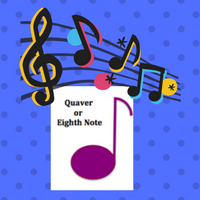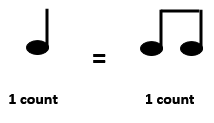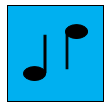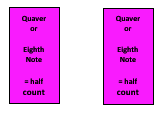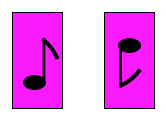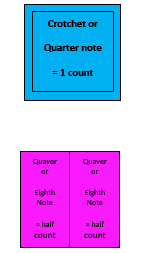To count and play the quaver (eighth notes) you need to understand what they are.
What is a Quaver ( Eighth Notes ) ?
A Quaver (Eighth Notes) (the name depends on which country you live ) is the name given to a note length in music, namely the half count note ( ½ count note ). It means that you keep the sound going for half ( ½ ) a count or beat.
What Does a Quaver ( Eighth Notes ) Look Like ?
Take a look below at what the Quaver (Eighth Notes) looks like:
there is 1 note on its’ own // 2 notes are grouped together
In relation to a crotchet or quarter note which is 1 count
Below are 2 pictures of what quavers look like on Sheet Music
This picture represents single quavers ( half count ) and twin quavers (groups of 2) for 1 count.
Feeling the Quaver ( Eighth Notes ) Length
To help feel the length of a quaver, clap and say words underneath the notes, as in the two examples below.
Activity
To help you visualize the concept of 1 crotchet = 2 quavers,
here is an activity to do.
1. Measure and cut out 2 squares measuring 6 cm by 6 cm
2. On 1 square:
On one side of the square write:
crotchet or
quarter note
= 1 count

Draw on the other side of the square the notes
3. Fold the other square in half and cut down the middle
4. Write the words below on one side of each smaller rectangle
quaver or eighth note
= half ( ½ ) count
Draw 1 note like below, on the other side of each smaller rectangle
5. With the set you have place the crotchet square on the surface.
Underneath this place the 2 quaver rectangles,side by side like you see below.
Can you see how the 2 quaver rectangles looks the same size as 1 crotchet square?
Both the blue crotchet square and the 2 pink quaver rectangles equal 1 count.
Each shape represents a length of sound.
So a quaver sound is half the length of a crotchet sound as indicated by the given shapes.
6. This is 1 set.
You can make as many sets as you like and create your own rhythms using 1 count and half count notes.
For example, with 2 sets you can create a rhythm like this:
 1 count 1 count 1 count 1 count
1 count 1 count 1 count 1 count
Counting the Quaver
Counting the quaver (eighth notes) and hence keeping in time can be tricky especially to young children who may not have a concept of fractions yet.
Here is an explanation
When you are counting the length of half ( 1/2 ) count notes you make a sound with a clap or note on an instrument for each note.
You say and count a number at the start of each beat such as 1 or 2 or 3 or 4 as marked by * below . For the notes between the 1 or 2 or 3 or 4 you say the word “and”. This is written with a ” +” sign. They represent the second half of the beat as marked by # below.
That is, if the 2 quaver notes are grouped together to equal one count or beat, then the number would always come on the first quaver and the “and” seen by a “+” sign is on the second quaver.
Take a look at the example below
* # * # * #
Activities
1. This is for 2 people or 2 groups using the 2 rhythms below.
1. Everyone claps and counts each of the 2 rhythms below.
2. 1 person or group claps and counts rhythm 1
3. The other person or group claps and counts rhythm 2
4. Everyone claps and counts their rhythm, so that rhythm 1 and 2 are sounded at the same time.
5. Repeat steps 2. to 5. but swap over to the other rhythm.
Rhythm 1
Rhythm 2
2. Rhythmic Patterns:
This is for individuals
Below is Suzie’s Rhythmic Pattern and spaces to write Your Rhythmic Pattern.
Suzie’s Rhythminc Pattern
Your Rhythmic Pattern:
Write it here using the notes and rest like in Suzie’s Rhythm.
For each rhythm do the following:
1. write the counts underneath
2. clap and count it
3. play it on any note on your instrument
3. Rhythm Cards:
This is a series of cards of notes of various time lengths eg 1, 2, 3, 4, ½ counts.
You can make these Note Length Cards.
1. Cut out 4 equal sized rectangles for each time length.
2. Draw the picture of 1, 2, 3, 4, ½ counts on the cut out rectangles. Do this 4 times.
3. Write the count value under each drawn note eg 1 count underneath the picture of a crotchet ( 1 count note )
Activity
1. Pick “x” note length cards eg 4 or 6 or 8
2. Arrange them in any order
3. Clap and count each note length from left to right eg 1 for a 1 count note and 1-2 for a 2 count note.
4. Play these note lengths on any note or notes on your instrument. You can choose rows of 1 note name eg B’s or use any of the note names you know so far.
Pieces Using the Quaver
Now you can play some pieces using the quaver (eighth notes)
Free Music
Click the blue title for Recorder Blues in G Major
Click the blue title for Flute Blues in F Major
Click the blue title for Piano Blues in C Major
Paid Music
Click Here for music to purchase
Finale
You have now read what the quaver (eighth notes) are, what it looks like, some activities to help in your understanding and counting and some pieces and exercises to play on your instrument.
Do You Now Know How To Count and Play
The Quaver (Eighth Notes)?
If you get stuck, ask me here for help.
